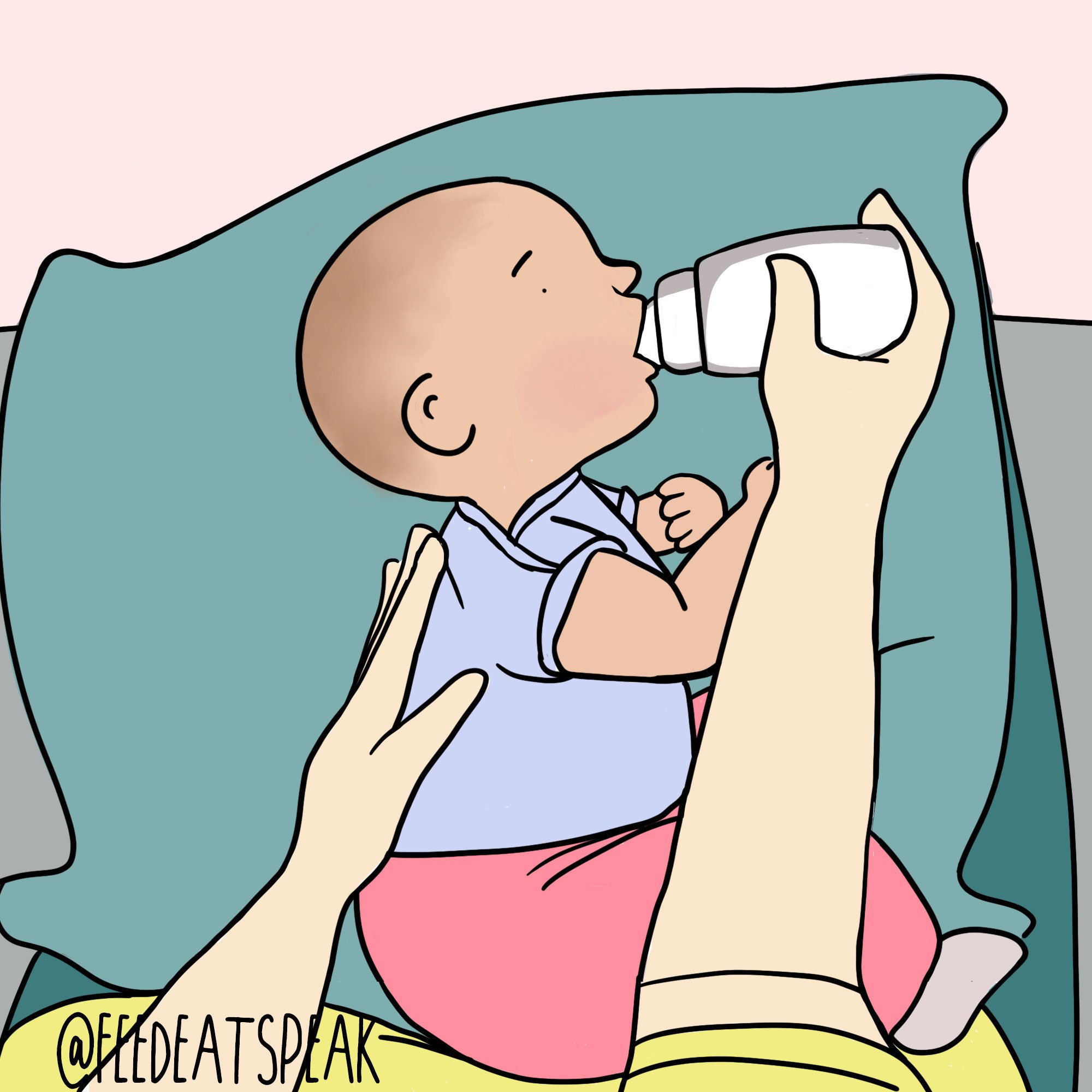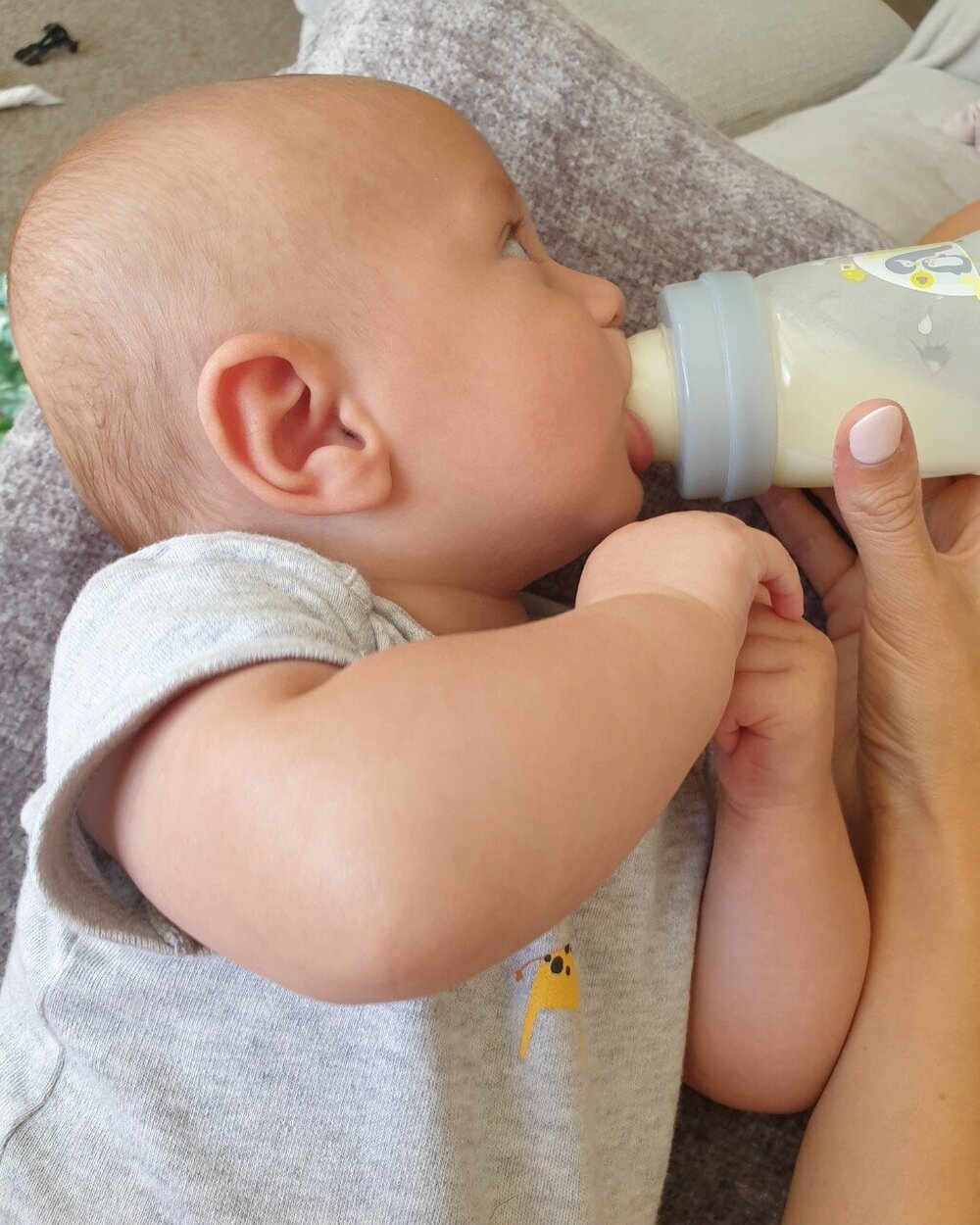Elevated side lying bottle feeding
Elevated side lying is a bottle-feeding position that’s being used more and more for preterm babies and infants who have feeding difficulties. In this blog post I’ll tell you why I like it for all new born babies. I’ve put together a visual step by step guide for you, so go ahead and give it a try…
This position is a natural and physiologically normal feeding position just like how a baby feeds at the breast. It means the baby doesn’t have to do any work at all to support its body while it feeds which makes for an easier and more relaxed feed for both the baby and you.
Baby is positioned on a cushion which means that you don’t have to take the baby’s weight on your arms which is more comfortable especially as your baby grows.
You have a hand free if you need it to read to a toddler or have a drink while you’re feeding your baby.
If the flow of milk is too fast - which it often can be at the start while your baby is mastering their suck swallow and breathe co-ordination – this position allows the milk to safely dribble out of your babies mouth instead of coughing while feeding.
You are able to clearly see your baby’s face and watch for signs that she may need a pause or a break for winding.
This is a great position for babies who have reflux or who are prone to vomiting. If you place the baby on its left side to feed it increases the space from the bottom of its stomach to the oesophagus making it less likely for them to vomit or reflux.
This feeding position is more typically recommended for formula fed babies, versus the paced bottle feeding technique which tends to be recommended for breastfed babies who also take the bottle. However I would suggest that with the horizontal presentation of the teat and the pacing as per the paced bottle feeding technique that this feeding position can be used in both groups of infants.
It is also a feeding position that you can experiment with and trial if your breastfed baby is refusing to take a bottle.
Step by step guide to elevated side lying bottle feeding
1.
Sit comfortably on the sofa and place your feet on a footstool. This plastic childrens' one from ikea does the trick. Your legs should be sloping from the knees to your hips
2.
Place your baby on their side with their bottom against your tummy. Baby’s legs should be out in front of them. If you're right handed then baby on their left side and visa versa
3.
Your baby will bring their hands together on their chest in a flexed position. Offer the bottle, wait for baby to open their mouth and place inside. Note how relaxed and content your baby looks
Chelsey and Jaxon's story
I had my baby boy Jaxson in April 2020 and he was born with a tongue tie which meant he wasn't able to latch comfortably when breast feeding. I could tell this was the issue from day one as his older brother was also born with one and we had the same feeding issue.
Due to the covid19 circumstances I wasn't able to get the tie cut with Jaxson as quickly as I did my 2 year old. So for 4 months I expressed every feed and bottle fed him. His tie was cut privately at 10 weeks old and I chose to continue to bottle feed.
Jaxson was a very windy baby and in the early days he really struggled to feed comfortably, he had lots of trapped wind which would not come up easily. He would cry in pain after most feeds which was very upsetting for both of us. I tried everything I could buy from the pharmacy as us mums do and also turned to social media where I found @feedeatspeak. I was scrolling though Stacey's feed and saw posts of the elevated side lying position. I immediately tried this with Jaxson who at the time was around 4 weeks old and he was a changed baby! He was able to bring up wind much easier and seemed so much more content. He actually started enjoying his feeds and upped the amount he was having quite soon after. I was one very happy Mama with a much happier baby!
So thanks to Stacey and her wonderful page, Jaxson now at 6 months old is still feeding is this position and he is one happy thriving baby!
I am so grateful for Stacey sharing this advice and information especially during lockdown as us new mums didn't really have anywhere to turn. So thank you so much for helping my baby!
I tell all my mummy friends about this feeding position and Stacey's page hoping to help their babies who struggle with bottle feeding. It really made a huge difference with Jaxson!
Grace and Mia's story
My 16 week old daughter Mia has suffered feeding difficulties, silent reflux and trouble with trapped wind and discomfort and pain since she was born.
Mia has seen the GP numerous times and been treated with special milk,infacol,dentinox, lactose reducing drops. I've been reading non stop about different remedies and help but no methods worked until I read Stacey’s elevated side lying bottle feeding article.
Well...it has completely cured Mias feeding difficulties, I had been told by the health visitor and the GP to feed her in an sat upright position and wind for a minimum of 30 minutes following each feed. Stacey’s article gave the opposite advice, but after trying this position once, Mia was like a different baby.
Enjoying her feed, burping halfway through and finishing her bottles in about 30 minutes instead of 3 hours!
I honestly cannot thank you enough for your magical advice.
For more advice and support about all aspects of feeding your little ones check out my instagram page and online courses.
References:
Clark L, Kennedy G, Pring T and Hird M (2007) Improving Bottle Feeding in Preterm Infants: Investigating the Elevated Side-lying Position. Infant. Vol 3, Issue 4, pp154-158
Ewer AK, James ME and Tobin JM (1999) Prone and left lateral positioning reduce gastro-oesophageal reflux in preterm infants. Archives of Disease in Childhood - Fetal and Neonatal Edition. 81:F201-F205.
Girgin BA, Gözen D, and Karatekin, G (2018) Effects of Two Different Feeding Positions on Physiological Characteristics and Feeding Performance of Preterm Infants: A Randomized Controlled Trial. Journal for Specialists in Pediatric Nursing. Vol 23, No2, pp e12214
Park J, Thoyre S, Knafl GJ, Hodges EA and Nix WB (2014) Efficacy of Semielevated Side-Lying Positioning During Bottle Feeding of Very Preterm Infants. Journal of Perinatal & Neonatal Nursing. Vol 28, No 1, pp 69-79
Raczyńska, A and Gulczyńska, E (2019) The Impact of Positioning on Bottle-feeding in Preterm Infants (≤ 34 GA). A Comparative Study of the Semi-elevated and the Side-lying position - a Pilot Study. Developmental Period Medicine. Vol 23, No 2, pp 117-124
Ross ES and Philbin K (2011) Supporting Oral Feeding in Fragile Infants. Journal of Perinatal & Neonatal Nursing. Vol 25, No 4, pp 349- 357






